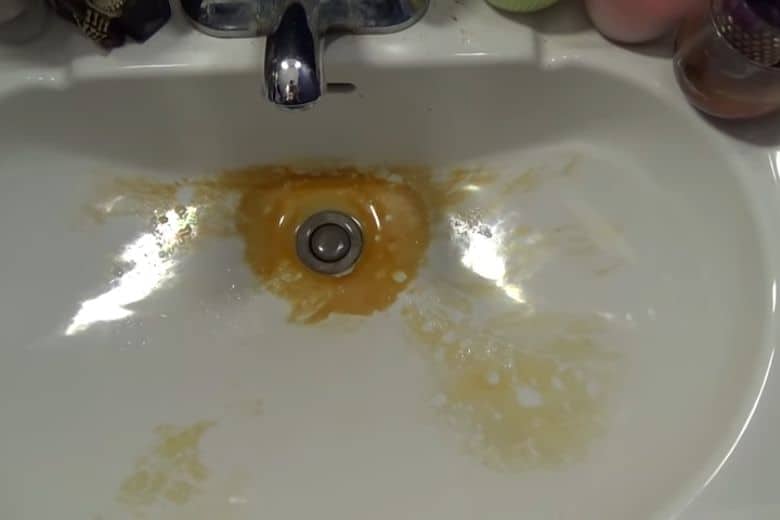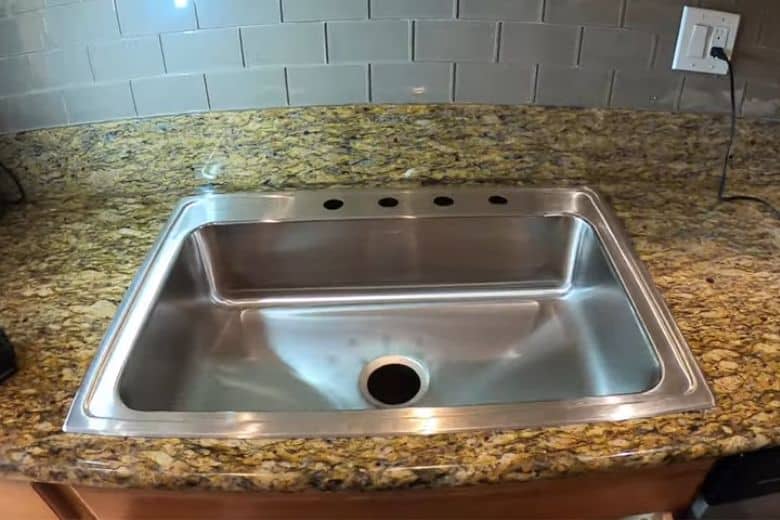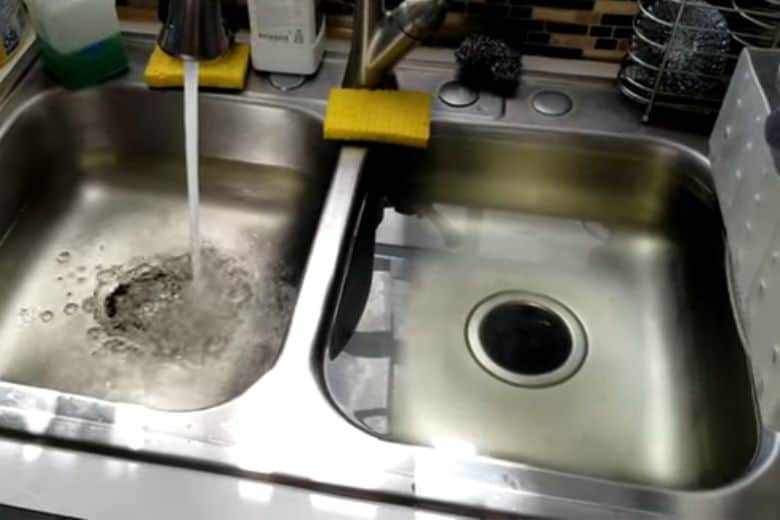Are you tired of seeing unsightly yellow stains on your bathroom sink? If so, you’re not alone. Many people struggle with removing these stubborn stains. But don’t know the effective way “how to remove yellow stains from bathroom sink”.
However, yellow stains on bathroom sinks can be caused by various factors, including hard water, mineral buildup, rust, and poor cleaning habits. Hard water is a common culprit, especially in areas with high mineral content in the water supply.
Regardless of the cause, keeping your bathroom sink clean and stain-free is essential for maintaining good hygiene and preventing the spread of harmful bacteria and mold.
So, why are you waiting? Let’s find out how to effectively clean the bathroom sink’s yellow stain.
Understanding the Causes of Yellow Stains in the Bathroom Sink
Hard Water and Mineral Buildup: If your home has hard water, which is water with high mineral content. It can leave behind yellow or brownish stains in your sink over time.
Over time, minerals such as calcium and magnesium can build up on the sink’s surface, causing a yellowish tint.
Rust: When the pipes or fixtures in your bathroom are made of metal, they can rust over time, which can cause yellow or orange stains to form in the sink.
Poor Cleaning Habit: Poor cleaning habits can also contribute to yellow stains. When you frequently neglect cleaning your sink, it can regularly allow dirt, grime, and other substances to accumulate and discolor the surface.
Use Oil Base Beauty Product: Yellow staining in a bathroom sink is often caused by oil buildup. Even if you might not think you’re using oily products in the bathroom. Using products with oil as a base, such as lotions, moisture, facewash and hair oil.
When you use these products near the sink and then rinse them down without wiping them up, the oils can accumulate at the bottom of the sink and lead to staining over time.
Soap Scum: Soap scum can build up and leave behind yellow or white stains. It happens when you clean your sink sparingly.
Cleaning Products: Some cleaning products, especially those that contain bleach, can discolor surfaces and leave behind yellow or brown stains if not rinsed off properly.
Tobacco or Nicotine: If someone in your household smokes, tobacco or nicotine residue can build up in your sink and leave behind yellow or brown stains.
Age of the Sink: Lastly, sinks can become discolored or stained simply from years of use and exposure to water and cleaning products.
Poor Ventilation: A lack of proper ventilation in the bathroom can cause moisture to build up, leading to mold and mildew growth, which can discolor the sink and cause yellow stains.
Understanding the causes of yellow stains can help you take steps to prevent them from occurring in the first place. And choose the most effective method for removing them if they do appear.
How to Remove Yellow Stains from Bathroom Sink (6 Separate Methods)
Today we will explore six effective methods for removing yellow stains from bathroom sinks and tips for preventing future stains. Whether dealing with mild discoloration or deep-set stains, this article will guide you to restore your sink to its former glory.
Let’s begin with the first method.
Method 1: Using Baking Soda and Vinegar to Remove Yellow Stains
Baking soda and vinegar is the most ancient and common home remedy often used to remove yellow stains. These two ingredients are easily accessible in every home kitchen and easy to apply.
- You will need baking soda, white vinegar, a small bowl, a measuring cup, a spoon, and a brush.
- Mix two tablespoons of baking soda and two tablespoons of white vinegar in a small bowl. Stir well until it forms a thick paste.
- Use a new or old used but clean brush to apply the paste on the yellow stain. Carefully the paste covers so that it can cover the entire stain.
- Leave the paste on the stain for about 30 minutes. It will give the paste enough time to penetrate the stain and work its magic.
- Rinse with water after 30 minutes, and rinse the stained area with water. Use a clean cloth to wipe away any remaining paste.
- If the stain is still visible, you can repeat the process with a time gap until the stain is completely gone.
Baking soda and vinegar are natural ingredients that work well in removing yellow stains. Baking soda is an alkaline substance that neutralizes acidic stains, such as sweat and urine, which often cause yellowing. Conversely, vinegar is acidic and works well in breaking down stubborn stains; combining the two forms a powerful solution that can remove even the toughest yellow stains.
Precaution
- Before using this method on the entire stain, test it on a small, inconspicuous area of the fabric.
- Baking soda and vinegar may bleach colored sink. Only use this method on the white or light-colored sink.
Method 2: Using Hydrogen Peroxide and Baking Soda to Remove Yellow Stains
The use of hydrogen peroxide and baking soda also helps remove yellow stains. Let’s see the application process:
- Gather the materials you need, like hydrogen peroxide, baking soda, a small bowl, a measuring cup, a spoon, and a brush.
- Mix hydrogen peroxide and baking soda in a small bowl. Take one tablespoon of hydrogen peroxide and one tablespoon of baking soda. Stir well until it forms a thick paste.
- Apply the paste by using a thin brush on the yellow stain. Ensure that the paste covers the entire stain.
- Now leave the paste on the stain for about 15 to 20 minutes. It will give the paste time to work on the stain.
- After 15 to 20 minutes, rinse the stained area with water. Use a soft clean cloth to wipe the area.
- If any satin remains repeated the same process next day.
Hydrogen peroxide is a powerful oxidizer that can break down stubborn stains. Baking soda, on the other hand, is an abrasive substance that helps to lift the stain. Combining the two ingredients forms a powerful solution that can remove even the toughest yellow stains.
Precaution
- Hydrogen peroxide and baking soda also can bleach colored sinks. So be aware before use.
Method 3: Apply Lemon and Salt Mixture to Remove Yellow Stain
At the time, your kitchen runs out of vinegar and baking soda. The mixture of lemon and salt is there to help you. It is another frequently used home remedy to clean sink and cloth stains.
- For the process you use need a lemon, salt, water, sponge or scrub brush, a small bowl and protective gloves (optional).
- Cut a lemon in half and squeeze the juice into a small bowl.
- Add a tablespoon of salt to the bowl and mix the lemon juice and salt.
- Dip your sponge or scrub brush into the mixture and apply it to the yellow stains on your sink.
- Let the mixture sit on the stains for 5-10 minutes.
- Scrub the stains with the sponge or brush, applying more mixture as needed.
- Rinse the sink with water to remove any remaining lemon and salt mixture.
- Dry the sink with a clean towel.
When combined, lemon juice and salt create a powerful cleaning agent that can dramatically remove stains and brighten surfaces. The acid in the lemon juice helps break down the stain, while the salt’s abrasive action helps scrub it away. Additionally, lemon and salt are natural and non-toxic, making them a safe and eco-friendly alternative to harsh chemical cleaners.
Precaution
- Lemon juice can be acidic and may irritate your skin. If you have sensitive skin, wearing gloves while using this mixture is a good idea.
- Avoid using this mixture on delicate surfaces or materials such as marble, as the acid in the lemon juice can cause damage.
Method 4: Embed Borax and Lemon Juice to Remove the Yellow Stain
Borax is a power and looks like a baking soda. However, the mixture of borax and lemon is beneficial in a different manner, including cleaning the stained surface.
- Arrange borax powder, lemon juice, water, a sponge or scrub brush, protective gloves and glasses if you have a sensitive sink.
- Mix 1/2 cup of borax powder with enough lemon juice (half or full, depending on stain size) to make a thick paste.
- Apply the paste to the yellow stains on your sink using a sponge or scrub brush.
- Let the paste sit on the stains for 15-30 minutes.
- Scrub the stains with the sponge or brush, applying more paste as needed.
- Rinse the sink with water to remove any remaining paste.
- Dry the sink with a microfiber cloth.
Borax powder breaks down dirt and grime, while lemon juice is a natural bleaching agent. Combined, they generate the finest cleaning product and help remove stains. Besides, borax and lemon juice are natural and non-toxic elements, so no other issue happens.
Precaution
- Since borax powder can irritate sensitive skin and eyes, it’s a good idea to wear gloves and glasses.
Method 5: Use Cream of Tartar and Hydrogen Peroxide
Using tartar cream and peroxide is a unique method to remove the stain. Cream of tartar is white power generally used to stabilize whipped egg white for making bakery items. Since it is an acidic ingredient, it has a stain-removing capacity.
- Gather all necessary ingredients like cream of tartar, bowl, hydrogen peroxide, scrubbing brush, etc.
- Now mix two tablespoons of cream of tartar with 2 or 3 tablespoons of hydrogen peroxide as needed to make a thick paste.
- Next, use a sponge or scrub brush to apply it to the yellow stains on your bathroom sink.
- After embed the paste on the stain area let it set for at least 10-15 minutes.
- Scrub the stains with the sponge or brush, applying more paste as needed.
- Rinse the sink with water to remove any remaining paste.
- Use a clean cloth or microfiber cloth to dry the sink.
Cream of tartar works as a mild abrasive that can effectively scrub away stains, while hydrogen peroxide acts as a natural bleaching agent that can help to remove discoloration.
Precaution
Avoid using the compound on surfaces such as marble, as the abrasive action of the cream of tartar can cause damage.
Method 6: Using Commercial Cleaners
Before using any commercial cleaner, you must understand the different types of available cleaners and their intended uses. Here are some common types of commercial cleaners:
- All-purpose cleaners: These are designed to be used on various surfaces and can effectively remove light to moderate stains.
- Specialty cleaners: Specialty cleaners are designed for specific surfaces or stains, such as carpets or bathroom cleaners.
- Stain removers: These cleaners are specifically designed to remove stubborn stains, such as yellow ones.
Here is the process of using a commercial cleaner on the yellow satin bathroom sink:
- Before using any commercial cleaner, it’s important to read the label and follow the instructions carefully.
- Before applying the cleaner to the stained area, test it in a small, inconspicuous area to ensure it won’t damage the surface.
- Apply the cleaner to the stained area, following the instructions on the label.
- Depending on the cleaner, you may need to let it sit for a certain amount of time to allow it to penetrate the stain.
- Use a brush or sponge to scrub the stained area, applying pressure as needed.
- Once the stain has been removed, rinse the area thoroughly with water.
Indeed, commercial cleaners can remove yellow stains. Nevertheless, it’s advised to understand the different types available and take the necessary precautions when using them.
Precaution
- Some cleaners can be harsh on the skin, so wearing gloves to protect your hands is a good idea.
- Many cleaners emit fumes that can be harmful if inhaled, so make sure to use them in a well-ventilated area.
- Always follow the instructions on the label carefully to avoid damaging the surface or causing injury.
Tips and Tricks for Preventing Future Stains in Your Bathroom Sink
Clean regularly: One of the best ways to prevent stains from developing in your bathroom sink is to clean it regularly. Use a mild cleaner and a soft sponge or cloth to wipe down the sink after each use.
Rinse Thoroughly: After using toothpaste, other products or beauty in the sink, rinse it thoroughly with water to remove any residue.
Buy a Drain Stopper: Using a drain stopper can help prevent hair and other debris from going down the drain and causing clogs.
Avoid Leaving Products on the Sink: To prevent stains from developing, avoid leaving toothpaste, soap, or other products on the sink for extended periods.
Install a Water Softener: Hard water is a common cause of yellow stains in sinks. Installing a water softener can help reduce mineral buildup and prevent stains from forming.
How to Maintain a Clean and Stain-Free Bathroom Sink
Use a Protective Coating: Applying a protective coating to your bathroom sink can help prevent stains from developing. Look for products specifically designed for this purpose at your local home improvement store.
Keep it Dry: Dry the sink thoroughly with a soft cloth or towel to prevent water spots from developing.
Avoid Abrasive Cleaners: Abrasive cleaners can scratch the surface of your sink, making it more prone to staining. Stick to mild cleaners and non-abrasive sponges or cloths.
Address Stains Promptly: If you notice a stain developing, address it promptly to prevent it from worsening. Use one of the methods discussed earlier in this article to remove the stain immediately.
Frequently Asks Questions
Can I use bleach to remove yellow stains from my bathroom sink?
Answer: While bleach can be effective in removing stains, it can also damage the surface of your sink and cause discoloration. We recommend using natural cleaning agents like vinegar and baking soda instead.
Can I use a steel wool pad to scrub my bathroom sink?
Answer: Steel wool pads can be abrasive and cause scratches on the surface of your sink. We recommend using a soft sponge or scrub brush instead.
How often should I clean my bathroom sink?
Answer: We recommend cleaning your sink at least once a week to prevent the buildup of mineral deposits and stains.
How do I know if my sink has been damaged by cleaning agents?
Answer: If your sink appears dull or discolored after cleaning, it may have been damaged by harsh chemicals or abrasive tools. We recommend using natural cleaning agents and gentle tools to avoid damage.
What should I do if the stains on my sink are not coming off?
Answer: Even after trying all the mentioned methods if still, the stains on your sink are stubborn and not coming off. You may need to call a professional cleaning service to help remove them.
Conclusion
In the end, you have indeed learned how to remove yellow stains from bathroom sink. However, with the right product and techniques, you can easily remove it. In addition, remember to clean your sink regularly and take steps to prevent stains from forming in the future.
Paul Newman is a blogger who writes about plumbing and home improvement. Over the past 20 years, I have worked as a plumber. My passion is to share my knowledge and experience with others to improve their homes.




